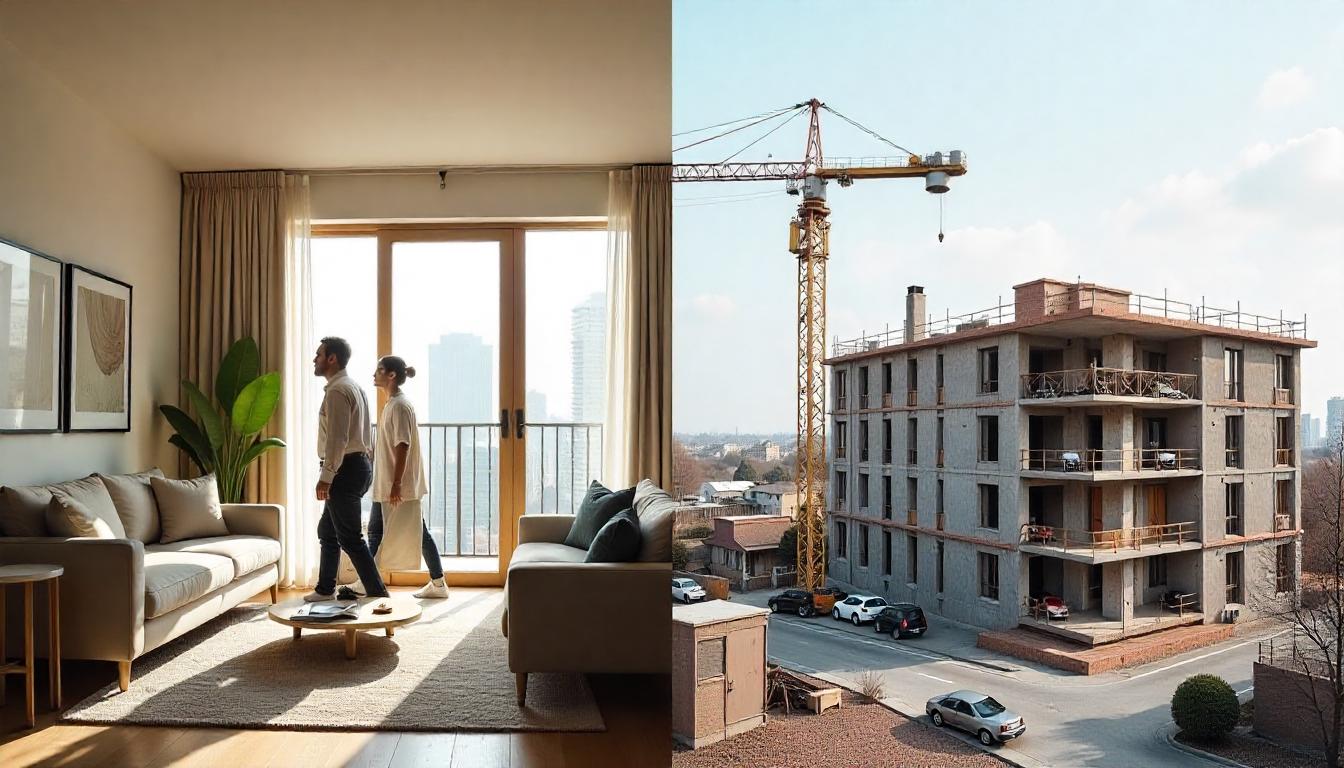
“Ready-to-move” vs “Under Construction” in India (2025): Which one is right for you?
If buying a home is a milestone, choosing between a ready-to-move (RTM) apartment and an under-construction (UC) one is the fork in the road that defines the journey. One gives the comfort of instant keys and zero uncertainty. The other promises a lower entry price and the thrill of watching value accrete as floors rise. In 2025’s Indian market—shaped by RERA enforcement, delivery-focused funding, and a taste for better amenities—both choices can be right. The art is matching the property to personal timelines, risk appetite, cash flows, and the developer’s track record.
This guide breaks it down simply, with current India-specific facts and practical checklists—so the decision feels confident, not complicated.
The big picture in 2025: why this choice matters
Demand is robust for both categories, but buyers have become far more discerning about developer credibility and delivery schedules under RERA. Many new launches are selling briskly in major markets, signalling confidence in under-construction projects by strong brands.
(JLL commentary on sales momentum; market trackers).
Price gaps remain meaningful: UC homes are typically listed at a discount to completed inventory, often around 15–20%, a differential widely referenced in market reporting.
(Hindustan Times analysis) — Hindustan Times.
RERA oversight and public funding support have reduced, not eliminated, execution risk. The SWAMIH Investment Fund (backed by the Ministry of Finance and managed by SBICAP Ventures) has already enabled completion of 50,000+ stuck homes and is targeting 20,000 completions a year for the next three years.
New Indian Express; SBI Ventures; ClearTax.Tax treatment differs: in most cases, GST applies to under-construction residential units (5% for non-affordable, 1% for affordable under specified caps), while completed/RTM homes with a completion/occupancy certificate are not subject to GST; stamp duty and registration are payable on both.
Razorpay Learn; Rustomjee.
Those four realities set the stage for a rational, numbers-and-needs-led choice.
Ready-to-move (RTM): who it suits and why it works
RTM means the apartment has received the completion certificate (CC) and typically the occupancy certificate (OC), and possession is available now.
What you’re buying:
Time certainty. Move in immediately, save on double outgo (rent plus pre-EMI), and avoid construction risk.
What-you-see-is-what-you-get. The real amenity quality, views, noise levels, and ventilation are right in front of you.
No GST. As a rule, GST isn’t applicable on completed RTM sales with CC/OC; only stamp duty and registration fees apply —
Razorpay Learn; Rustomjee.
Best for:
Households paying substantial rent who want to stop the rent meter today.
Buyers with infants/elders who prioritise reducing stress and disruption.
NRI buyers who value certainty and immediate occupation/lease potential.
Watch-outs:
Higher ticket price versus comparable UC in the same micro-market (the UC-RTM gap often cited at 15–20%)
Hindustan Times.Lower customisation. Scope for changing tiles/fittings is limited.
Inventory selection may be narrower; prime stacks/floor plates may be taken.
Due diligence checklist (RTM):
Verify completion and occupancy certificates; match the unit’s sanctioned plans to “as-built”.
Confirm society handover status: pending snag rectifications, facility operations, sinking fund, and corpus.
Review maintenance history, lift/electrical contracts, and water sourcing.
Cross-check RERA disclosures for the project (even completed projects carry histories on state portals).
Under construction (UC): who it suits and why it’s compelling
UC homes are purchased during the building process. Payments are staggered, often linked to construction milestones—now tightly regulated under RERA.
What you’re buying:
Price advantage and capital appreciation potential. Entry prices are usually lower than RTM, and values can step up across phases and completion (often 15–20% difference cited in reportage) — Hindustan Times.
Fresh inventory. Better choice of floors, views, and stacks; latest specifications and amenity programming.
Cash flow flexibility via milestone-linked plans under RERA.
Best for:
Buyers with 18–36 months’ runway who value selection and potential appreciation.
Investors targeting handover-time rental yields in high-demand corridors.
End-users are comfortable with a known, credible developer’s delivery record.
Risks—and how the market is addressing them:
Delivery delays. RERA mandates registration, escrowed project funds, and compensation for delay; buyers can monitor progress via state RERA portals. Enforcement has toughened, with stricter penalties for misrepresentation/delays reported by multiple state authorities and trackers — State RERA communications; sector explainers.
Stalled legacy projects. The SWAMIH Investment Fund has stepped in to complete stressed, RERA-registered affordable and mid-income projects—50,000 completions to date; 20,000/year targeted in the next three years — New Indian Express; SBI Ventures; ClearTax.
GST impact. UC attracts GST (generally 5% for non-affordable, 1% for qualifying affordable units), while stamp duty and registration also apply; confirm if ITC benefits are factored in pricing (many schemes are priced net of ITC) — Razorpay Learn.
Due diligence checklist (UC):
Validate RERA registration number, sanctioned plans, and quarterly updates on the state portal (timeline, approvals, escrow).
Run a quick scan of the developer’s last 3–5 projects: actual possession dates vs promised, defect issue resolution, and operations quality.
Understand payment schedule, cancellation terms, late-payment interest, and compensation clauses for delay.
Look for ring-fencing: separate escrow, lender oversight, and visible site progress with geotagged updates.
Cost of waiting vs cost of certainty: a simple money lens
The “double outgo” problem is fundamental if a UC project slips: paying rent plus pre-EMI for longer can erode the initial discount. A 12-month delay can mean lakhs in extra outflow for metropolitan households, which is why RERA’s penalty/compensation clauses matter—and why many buyers lean towards brands with demonstrably on-time delivery. Practical finance illustrations echo this across developer blogs and buyer advisories; verify math for personal rent/EMI.
Conversely, with on-schedule delivery, buyers capture appreciation from under-construction to completion while having benefited from staggered payments—often a meaningful internal rate of return for the risk taken.
Taxes tilt differently: no GST on RTM; GST on UC (5%/1% bands) on top of stamp duty means all-in price comparisons should be made net of every levy and rebate — Razorpay Learn; Rustomjee.
Legal and documentation: getting the paperwork right
For RTM:
Completion Certificate (CC) and Occupancy Certificate (OC) must be genuine and traceable to the competent authority; ensure no major deviations from sanctioned plans.
Check for any pending litigations, association formation, common area conveyance plans, and property tax status.
For UC:
Mandatory RERA registration with all key approvals listed; land title clarity (encumbrance-free), commencement certificate(s), and environmental clearances where applicable.
Allotment letter and Agreement for Sale should reference RERA norms, possession date, penalty for delay, and carpet area as per RERA definitions.
RERA has materially improved buyer protection, requiring phased payments tied to construction milestones and restricting fund diversion by developers through project escrows — RERA acts and state portals (see your state RERA website for current disclosures and advisories).
A decision framework for Indian buyers in 2025
Choose Ready-to-move if:
Moving within 0–6 months; a large rent outflow makes waiting expensive.
Prefer certainty over incremental savings.
Want clarity on liveability and association management before paying.
Choose Under construction if:
Comfortable with 18–36 months’ horizon.
Prioritise selection, newer specifications, and appreciation potential.
Buying from a credible, well-capitalised developer with a verifiable delivery record under RERA.
Hybrid approach:
Buy late-stage UC (near completion) to capture part of the price gap while reducing delivery risk. Validate site status, occupation timelines, and OC readiness with the developer and on the RERA portal.
Taxes and transaction costs: know the difference
Risk, reduced: what’s changed post-RERA and SWAMIH
RERA enforcement has standardised disclosures (carpet area, timelines), escrowed collections, and compensation for delay, substantially diluting the information asymmetry buyers once faced — RERA/state portals; sector explainers.
SWAMIH Fund’s completion record—50,000+ deliveries to date, to deliver 20,000 units annually—has de-risked many stuck mid-income and affordable projects, restoring confidence and clearing legacy pain points — New Indian Express, SBI Ventures, ClearTax.
Still, diligence is non-negotiable: stick to developers with verifiable, timely-delivery histories, clean approvals, and transparent update practices on RERA portals.
A quick buyer’s checklist
For RTM:
CC/OC copies; match to sanctioned drawings.
Society handover status; maintenance and sinking fund details.
Liveability audit: noise, water source, traffic circulation, parking convenience.
No-GST confirmation in writing; calculate stamp duty/registration.
For UC:
RERA number, approvals, and escrow details on the state RERA website.
The developer’s last 3–5 project delivery record; speak to past buyers if possible.
Possession date, per-day/month compensation for delay, penalty symmetry.
All-in pricing (base+GST+duties+extras), and cash flow schedule aligned to salary inflows/bonuses.
The bottom line
There’s no one-size-fits-all answer. Choosing between ready-to-move and under-construction depends on your priorities—speed, budget, risk appetite, or investment horizon. The smart choice is informed; trust reputable developers, ensure transparency, and align the property with your vision for the future.









